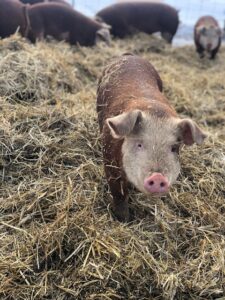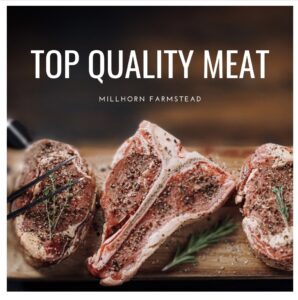Raising pigs in the winter.
I know, why would I do this? Winter is hard. It’s frozen and There’s 3 feet of snow! And that’s actually why, I raise pigs in winter.
When I first started raising hogs for harvest, I did one batch per year. Starting with 6 week old piglets in March. This would fill my family’s freezer in September. However, by February, our freezer was once again out of pork, I did not have room for two pigs in the freezer and my husband may actually divorce me if I bought yet another deep freeze! (I may or may not have 5 refrigerators, but that a different topic and day with the counselor 🙂
One year on a bacon thirsty limb, I decided to pick up a few weaner pigs in October to raise over the winter. The piglets were 8 weeks old, weaned and eating grain. I had extra milk to help boost their calories and continued to feed them a local grain ration until March. And in March…there was pork again in my freezer. Glorious, wholesome pork! I now raise butcher hogs twice a year, both in the summer and in the winter. And as it turns out, raising pigs in the winter, is my favorite!
Benefits of raising pigs in the winter.
- No flies. Did you hear me y’all?? I said no flies. With the freezing temperatures, comes dormant insects, this includes the pesky fly.
2. No smell. Besides the obvious frozen feces aspect of winter, the heavy bedding, aka carbon, all but eliminates any odor.
3. More bacon. For reals. During the winter months, pigs sleep more to preserve energy. With inactivity, comes more body weight. On our farm, I see pigs gain weight faster, eat less and yield more during the winter months.
Planning.
Here in Idaho our temperatures drop in the single digits, sometimes into the negatives, so being well prepared and having thorough plan BEFORE the weather turns is key. There are many aspects to think about while planning to raise pigs over winter. Shelter, feed, fresh water, trailer and hauling accessibility are the most important.
Shelter.
Pigs must have shelter. You don’t a need a pig barn or a fancy building but you do need shelter. Unless you raise a wooly pig, like the Mangalitsa, than your pigs will be lacking a necessary “winter coat”. To compensate for their lack of hair, pigs need shelter from the elements, like wind, rain and snow. I have built many hog shelters before out of old pallets, straw bales and even water towers. While they all have their perks, my favorite is the straw hut. Yup, just like in Little Red Riding Hood, (besides the whole huff and puff, blow your house down part). Straw is incredibly insulating, hence the reason they are building homes out of it all over the world. The downsize is eventually they will rot, however they will become great compost for the garden. I have easily gotten 2 seasons out of one straw house. Ask a local farmer for “kick outs”, these are typically cheap if not free.
Hog shelters do not need to be expensive, but they do need to be tough and sturdy.
Bedding
Straw is the preferred choice for bedding for pigs over shavings. Shavings will absorb moisture more rapidly and mash down, making it a expensive form of bedding. Straw is insulating and the pigs will burrow down in it to keep warm. Add several inches of fresh straw when it gets matted down and the pigs are no longer able to root it up. As long as there is adequate ventilation, a deep litter method will keep pigs very warm during the winter.
Waterer
Pigs can not gain weight without adequate water intake. Fluid is the single most important aspect in a pigs diet. Keeping waters thawed during the winter is definitely challenging. But with a little planning, you can make it whole lot easier. I raise a dozen or two pigs in a batch at a time and thats alot of water! I love THIS hog waterer. Bonus, you can drop a trough heater in it and you are golden during freezing temps. No power… No problem. Rubber bowls are great for watering. They are cheap and the ice can be easily tipped out.
Feed
During the colder winter months, pigs will need a higher caloric intake to keep them warm and maintain a steady growth process. Because I own a raw dairy and have access to excessive milk and my piggies are spoiled with a couple gallons per day. When milk is tight, I supplement them with whey or a bale of alfalfa. Pigs LOVE alfalfa and because they are not ruminators, you don’t need to worry about bloat. When milk and alfalfa is not available, plenty of kitchen scraps will do. Save your water from boiling potatoes, noodles or hard boiling eggs and pour it into a bucket full of grain. Feeding wet feed to pigs, also will increase consumption, aka weight gain.
Trailer access
If your pigs will be going to butcher, then you will need to make sure that in the depth of winter with snow and mud, that you can easily get a trailer backed up to load them. This is something I have forgotten about several times while raising pigs in winter. Not having adequate trailer access could result in utter mayhem. Pigs will not load themselves, so be sure to not overlook this step.





